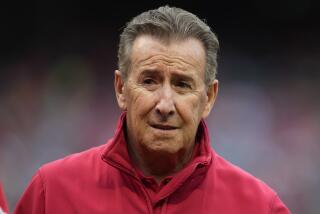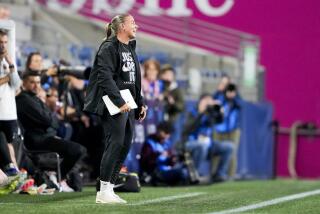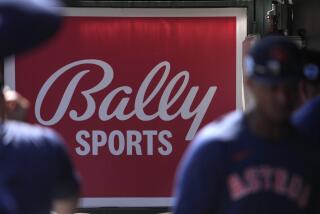Shining Example
When the New York Yankees unveiled the renovated Yankee Stadium in 1976, the storied club dusted off its ghosts. In a new Monument Park behind the center-field fence, the Yankees polished and displayed their collection of plaques, honoring the greatest figures of the greatest franchise in baseball history.
As the Angels unwrap renovated Edison Field this year, the club would like nothing more than to exorcise its ghosts. Disney rid itself of the stadium name--Anaheim Stadium, R.I.P.--and the listless stadium feel, but all the magicians and marketers in Michael Eisnerâs court cannot rid the Angels of the ghost of Dave Henderson.
âRe-marketing the Angels from a public perspective is one of the toughest things we face,â Angel President Tony Tavares said. âWhile I think weâve done a good job of putting a quality product on the field, convincing the marketplace weâre for real--overcoming 30 years of skepticism--is not easy. You donât do it overnight.â
In 1996, Disney strutted into its first season of baseball management promising fans a âtotal entertainment experience.â After two seasons of trial and error--many errors, including decibel-busting countdowns to the first pitch and bands and cheerleaders cavorting atop the dugout roof--a chastened Disney invites estranged fans to return to the ballpark.
âBallparkâ is the preferred term, not âentertainment center,â although either term fits after a $117-million stadium renovation. And, although the ballpark is the focus of a multimedia advertising spree unprecedented in franchise history, Disney promises to embrace the most old-fashioned of all marketing tools: a winning team.
After all, though the Angels sold out Anaheim Stadium for the 1986 American League playoffs, no one who witnessed Hendersonâs timeless home run for Boston--the one that robbed the Angels of their invitation to the World Series--walked away from the stadium talking about a âtotal entertainment experience.â
Edison Field features the club seats and luxury suites, food courts and beer gardens, interactive games and asymmetrical outfield dimensions so popular in such celebrated new ballparks as Baltimoreâs Camden Yards, Clevelandâs Jacobs Field and Atlantaâs Turner Field.
Architects reclaimed a ballpark feel by demolishing the distant outfield seating decks, reopening a window on the Orange Freeway and the mountains beyond and reducing capacity to a cozy 45,050. Designers stamped the project as distinctly Disney with giant caps and bats decorating the home plate entrance plaza and hydraulic and pyrotechnic displays behind center field.
So far, the Angels have been immune to Disneyâs legendary marketing magic. When Disney assumed control of the Angels two years ago, attendance declined for the fifth consecutive full season. Attendance dropped again last season, to 1.77 million, lowest in a non-strike season since 1978 and more than 1 million below the franchise record of 1982.
âItâs not like Disney can come in and sprinkle a little pixie dust and wave a magic wand and, all of a sudden, 2.5 million people appear,â Tavares said.
But that is the goal this season, and Disney is sparing no expense or expertise.
The marketing campaign, orchestrated not in the Angelsâ front office but at corporate headquarters in Burbank and brought to you by the same creative team that drove record Disneyland attendance two years ago by relentlessly plugging the farewell of the Main Street Electrical Parade, touts the grand opening of the renovated ballpark with such slogans as, âThereâs a Brand New Theme Park in Anaheim . . . Electric Light Parade Not Includedâ and âKiss Your Big A Goodbye.â
Disney designed, printed and inserted about 1.2 million eight-page, full-color advertising brochures in Sunday newspapers within the Angelsâ target marketing area of Orange and Riverside counties and southern Los Angeles County.
The advertisement--on one day--cost an estimated $360,000. In the final years of Autry family management, the Angelsâ marketing budget for the entire season generally ranged from $250,000 to $300,000.
Disneyâs stadium marketing blitz, valued by one source at $3-4 million, also includes direct mail, billboards, signs on buses and bus shelters and radio and television spots in English and Spanish. The Spanish-language spots are part of the first Latino advertising budget in franchise history. Disney also furnished a âGrand Slam Vanâ as an advertisement on wheels, with games, exhibits and a portable ticket window inside.
âWe think, in some ways, the ballpark will sell itself if we can get people in here,â said Ken Wachter, the Angelsâ vice president of sales and marketing.
To do that, Disney violates the conventional wisdom of reserving top promotions for the summer, when children are out of school, and for weeknights, to boost smaller crowds. Disney discovered that fans flock to fireworks shows, so the Angels have scheduled them every Friday. There will be a promotion for each game of the opening homestand, and for all but six of the first 24 home games.
âGood promotions, not just junk promotions. Nobodyâs showing up to get a shower curtain,â Tavares said, citing an Angel give-away item in 1993.
Disney wonât promote the ballpark this hard all summer. Angel executives, pointing to the Chicago White Sox and Texas Rangers, realize the attendance honeymoon will not linger past this year if the Angels do not field a competitive team.
âYou canât get lulled into thinking the building is what fans are coming to see,â said Kevin Uhlich, the Angelsâ director of stadium operations. âTheyâre coming to see the whole package, with the emphasis on what you do between the white lines.â
The Angels lost $27 million in the first two seasons under Disney management. Tavares said revenue from the seats, suites and signs of Edison Field will allow the team to âat least be in a position where weâre losing less money than the vast majority of people out there.â
In a show of good faith--in the fans, in the players and in their own marketing skills--Disney approved a budget increase to sign pitcher Jack McDowell, with whom Tavares predicted the Angels could reach the league championship series for the first time since Henderson hit that deflating home run. The Angels will open the season with a player payroll of $40 million, a club record and a figure that could rise to $45 million should McDowell fulfill numerous incentive clauses.
Disneyland, perhaps, is a âtotal entertainment experience.â The Angels are the team that coughed up an 11-game lead in 1995, a 3-1 lead in the best-of-seven league championship series in 1986 and a 2-0 lead in the best-of-five championship series in 1982 against Milwaukee.
Wishing upon a star, it turns out, is not enough. Paying and playing stars works better in baseball, and Tavares believes Burbank realizes that.
âEuro Disney was not exactly a smashing success when it came out,â Tavares said.
âWe are a product-driven company. I think Michael Eisner, first and foremost, understands product is what drives the company. You could market the hell out of Disneyland and Disney World. If the rides werenât up to snuff, if the experience wasnât great--the core thing youâre selling--all the marketing in the world wouldnât make it successful.â
(BEGIN TEXT OF INFOBOX / INFOGRAPHIC)
Edison Field
The Angels hope to draw 2.5 million fans to Edison Field. To meet that goal, they need to increase attendance 42% from last season, matching the largest increase of any major league club moving into a new stadium within the last decade. If history holds true, the Angels also will need to finish strong in the American League West. From 1979-90, a span that included the Angelsâ three division championships, the club drew 2.5 million eight times.
The Angels averaged 21,819 last season and placed second in the American League West standings. With the exception of the Colorado Rockies, who lowered seating capacity by moving from Mile High Stadium to Coors Field, here is a look at the average attendance and division finish of major league teams moving into new homes within the past decade:
*--*
YEAR STADIUM ATTENDANCE FINISH ATLANTA BRAVES 1996 Atlanta-Fulton County Stadium 35,818 first 1997 Turner Field 42,765 (up 19%) first BALTIMORE ORIOLES 1991 Memorial Stadium 32,313 sixth 1992 Camden Yards 44,598 (up 38%) third CHICAGO WHITE SOX 1990 Old Comiskey Park 25,346 second 1991 New Comiskey Park 36,677 (up 31%) second CLEVELAND INDIANS 1993 Municipal Stadium 27,224 sixth 1994 Jacobs Field 39,121 (up 30%) second TEXAS RANGERS 1993 Arlington Stadium 28,413 second 1994 The Ballpark in Arlington 40,374 (up 42%) first TORONTO BLUE JAYS 1988 Exhibition Stadium 32,039 third *1989 Skydome 42,199 (up 32%) first
*--*
*The Blue Jays moved into the Skydome June 5, 1989
More to Read
Go beyond the scoreboard
Get the latest on L.A.'s teams in the daily Sports Report newsletter.
You may occasionally receive promotional content from the Los Angeles Times.







